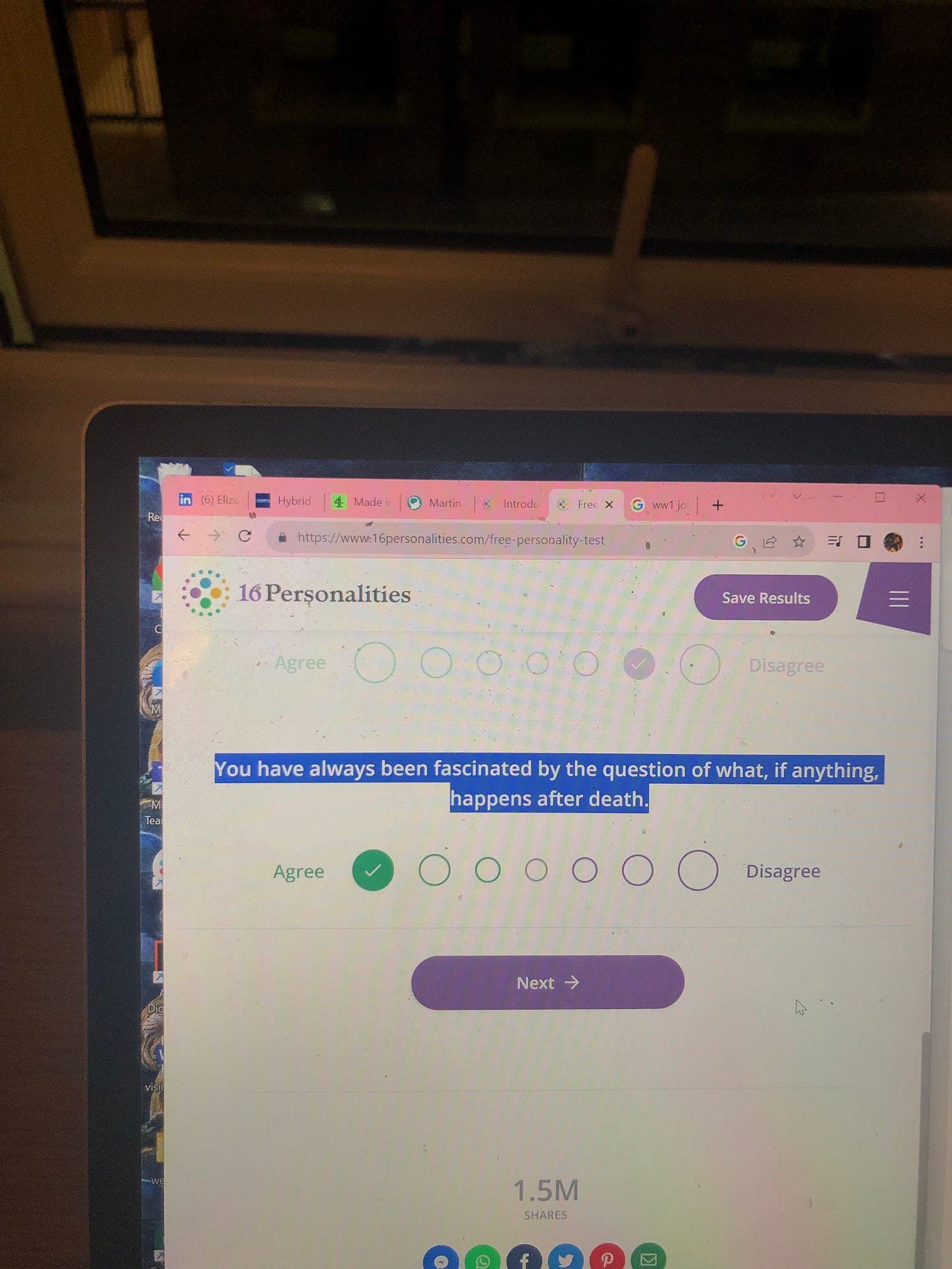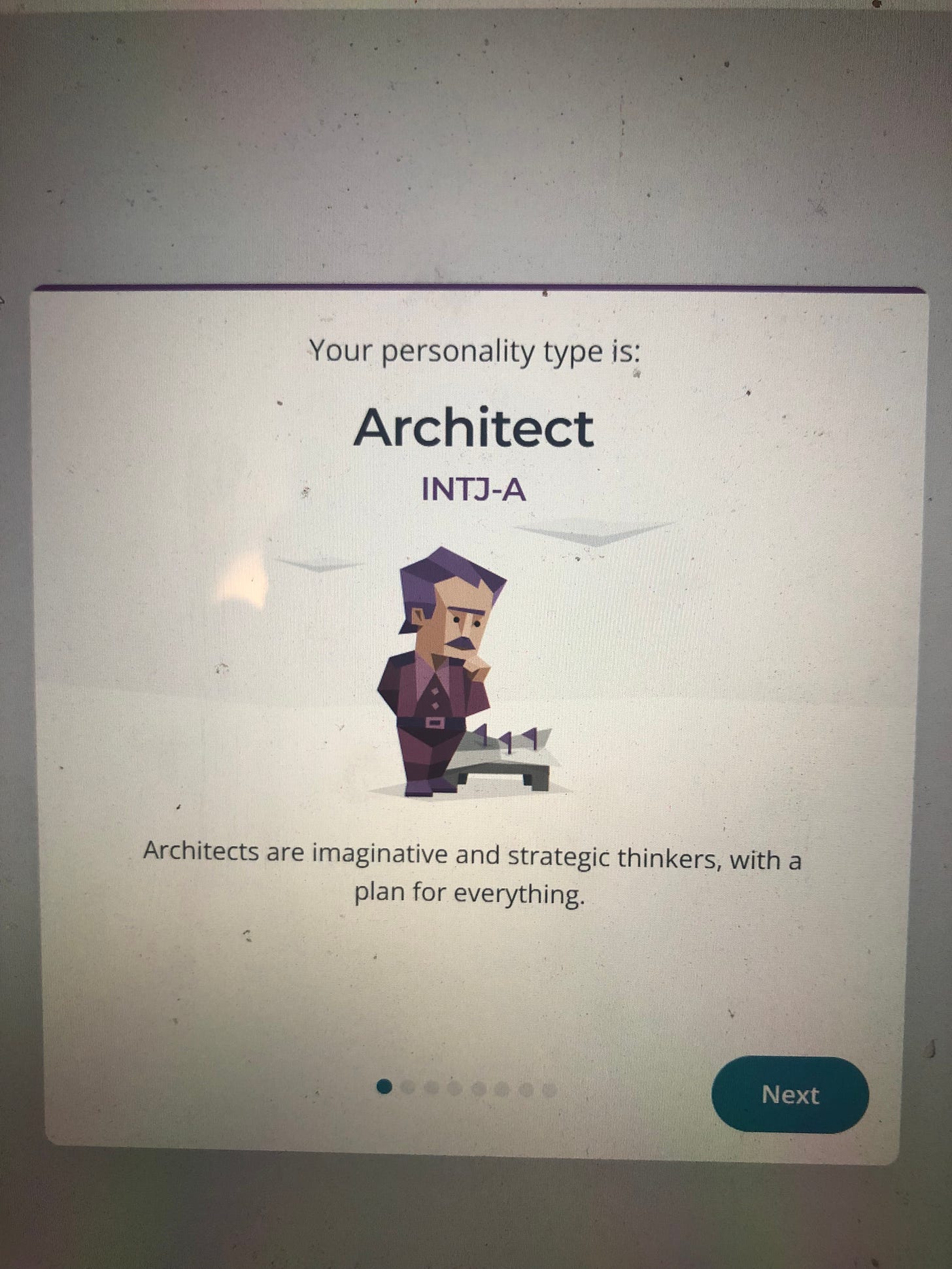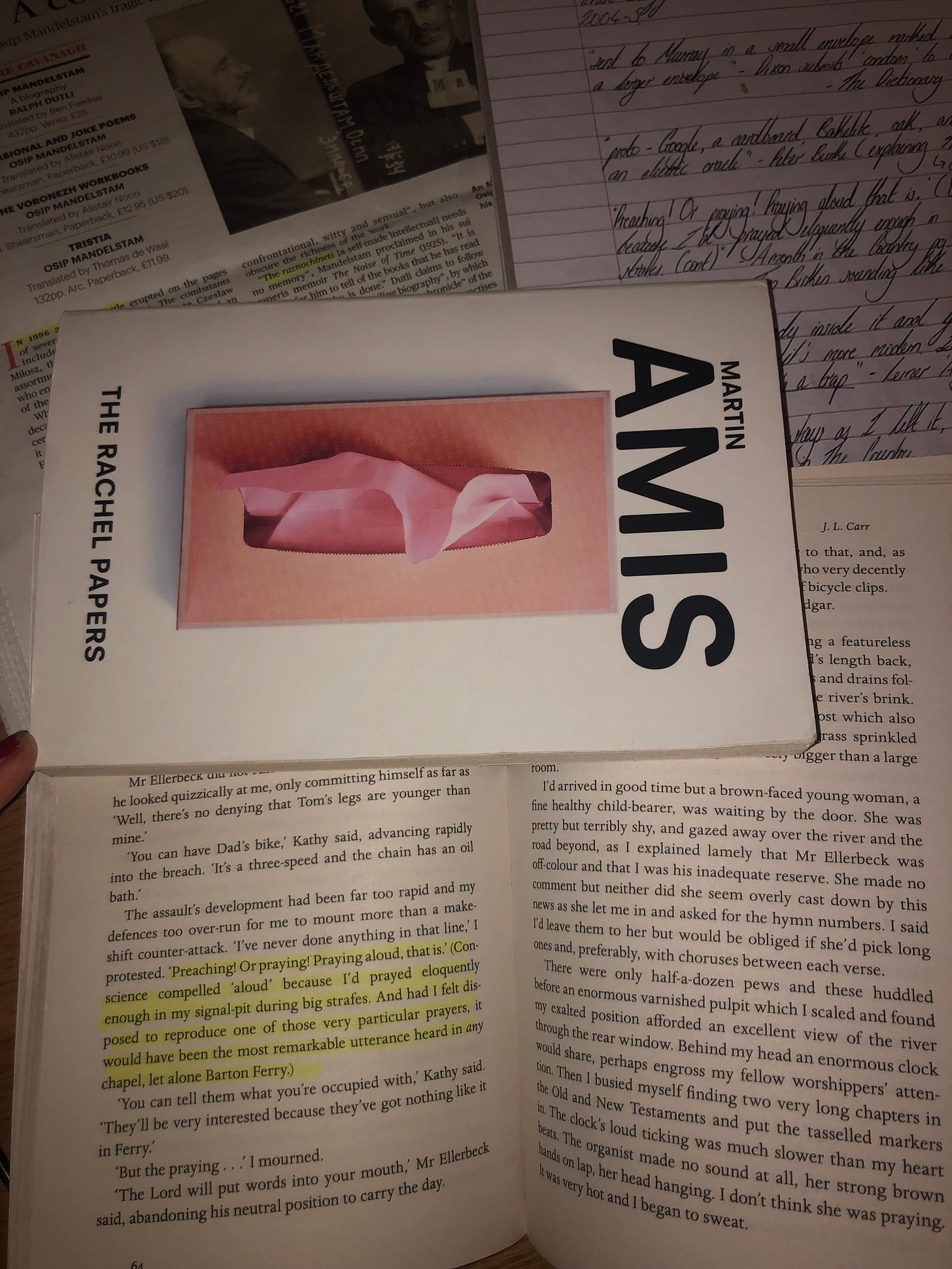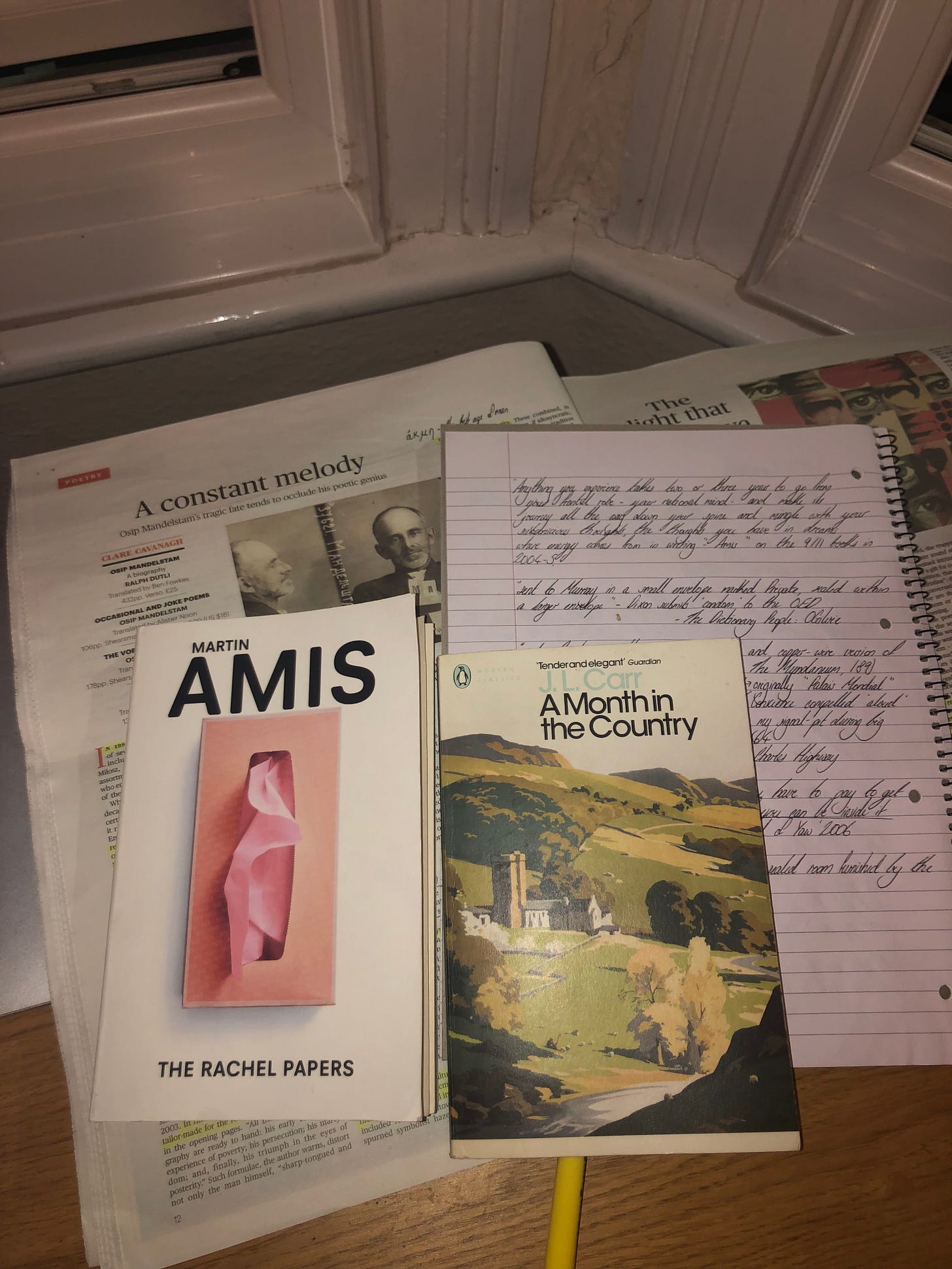Mr Highway and Mr Birkin
The muse of brilliant, young, male characters, brought Martin Amis and J. L. Carr the same one. I prove it using maths and science.
The muse of brilliant, young, male characters, brought Martin Amis and J. L. Carr the same one. Not similar, the same. If Charles Highway (The Rachel Papers, 1973) had spent his 20th birthday crawling through no man’s land as an advance signaller he would have moved to the parish of Oxgodby to restore a medieval church painting. And, if the gentle Tom Birkin (A Month in the Country, 1987) had been born into a dysfunctional upper-class family in the 1950s, he would over-analyse Blake, over-pop zits and take note of the “worms of dirt” “undulating” on the stomach of the girl he “just so happened to be poking at the time.” They seem so different but they are the same, down to their cadence and up to their fear of death. The first step towards proving my hypothesis is a Myers-Briggs personality test.
Any reader of The Rachel Papers knows Charles Highway more intimately than they would like to and I can pick his answers without a second thought. I know which lines of poetry he recites to delay ejaculation; the test is finished just as quickly. “You often make a backup plan for a backup plan.” Strongly agree. “Your happiness comes more from helping others accomplish things than your own accomplishments.” Disagree, although not strongly. The results are in as INTJ: “It can be lonely at the top. As one of the rarest personality types – and one of the most capable – ‘Architects’ (INTJs) know this all too well.” He would be so flattered.
The Myers-Briggs test consists of one hundred questions and is determined by measurements along 4 dichotomies: Extroverted vs. Introverted, Sensing vs. Intuition, Thinking vs. Feeling, and Judging vs. Perceiving. The result is 16 personality types that supposedly encompass everyone who ever lived. One arbitrary database has Martin Amis down as ENFP, which is probably wrong considering this is a quasi-autobiographical text and my methodology is watertight.
Carr’s veteran turned art restorer Tom Birkin is good-natured to his parochial friends but possesses a droll, stoic inner monologue. He cuts a more reserved character than Highway and his answers take some deliberation. Is he fascinated by what comes after death? He couldn’t not be, but I’m unsure whether he would avoid making phone calls.
One hundred hypotheticals later Tom Birkin is, groundbreakingly, also an INTJ. The profile is a perfect match. He does indeed prefer to completely finish one project before starting another. It’s worth noting that very few individual answers were the same across the tests, yet here they are at the same outcome: “imaginative and strategic thinkers, with a plan for everything.” This is the rarest type but it's also the one I'm assigned when I do the quiz as myself – the methodology crumbles further but perhaps that’s why I saw the similarities.
The only difference is that Birkin comes back as an “assertive” INTJ as opposed to Highway’s “turbulent” expression. This is why you would be forgiven for finding the two men very different. Assertive individuals like Birkin “are self-assured, even-tempered, and resistant to stress.” They “refuse to worry too much and tend to be self-confident when striving to achieve goals." On the other hand, “success-driven” turbulent types like Highway are more self-conscious, and motivated by external perceptions.
This is the most changeable part of the personality type, and the difference can be attributed to the age gap. Highway would certainly be more self-assured if we met him a decade later. I think this turbulent/assertive distinction actually accounts for the texts’ very different readerships which is likely why this scholarly breakthrough has never been made before.
The Rachel Papers was recommended by my friend Tom (what are the chances? It all connects!) who evidently absorbed the entire Amis corpus during the critical years of his prefrontal cortex development. The turbulent aesthetic is deeply ingrained; Tom is clever enough to get a debut novel out by 24 and if he miraculously becomes friends with Christopher Hitchens in middle age I won’t ask any questions. A Month in The Country was a gift from my mum’s friend Gina, who (very lovely, well-dressed, great conversationalist), seems pretty self-assured to me. Tom and Gina would not be in the same book club.
Now we have to go into English essay mode to flesh out the argument. Both characters are creatives, with an analytical eye that breeds self-awareness and social commentary. This is the sentence of Birkin’s where I recognised him for Charles Highway:
“preaching! Or praying! Praying aloud that is.’ Conscience compelled ‘aloud’ because I’d prayed eloquently enough in my signal-pit during big strafes. And I had felt disposed to reproduce one of those very particular prayers, it would have been the most remarkable utterance heard in any chapel, let alone Barton Ferry.” (p. 64)
Highway is somewhere around the bathos of "remarkable utterance." He hovers above the promotion of "Or" in a two-word sentence and in the dry humour that sees eloquence in warfare.
Another clear similarity in their voices is the application of literary quotes to the day-to-day, a technique that reveals the precise eye of the INTJ artist. Whether it's old English biblical text or a line of T.S. Eliot, both characters are embroiled in intertextuality and map out their emotional life within a literary web. This sense of reception and criticism is perfectly suited to the memoir structures where Highway and Birkin comment on their younger selves. There is continuity between the older iteration of the character and the younger one. In their theory of narrative experience, Galen Strawson argues that people experience time either “diachronically” or “episodically.”
“The basic form of Diachronic self-experience [D] is that one naturally figures oneself, considered as a self, as something that was there in the (further) past and will be there in the (further) future—something that has relatively long-term diachronic continuity, something that persists over a long stretch of time, perhaps for life. I take it that many people are naturally Diachronic, and that many who are Diachronic are also Narrative.”
“If one is Episodic [E], by contrast, one does not figure oneself, considered as a self, as something that was there in the (further) past and will be there in the (further) future, although one is perfectly well aware that one has long-term continuity considered as a whole human being. Episodics are likely to have no particular tendency to see their life in Narrative terms.”
(Strawson, TLS, 2004)
Strawson posits that these opposed “styles of temporal being” are inherent and distinct. Whether you’re episodic or diachronic it is all you know and it would never cross your mind that other people may figure their temporal narrative in a different way. Yet Birkin and Highway straddle both modes. Each experiences narrative from the diachronic lens, but is aware of and sometimes even appeals to, an episodic nostalgia.
Highway’s papers, with their melodramatic delineation of 19 from 20, can be read as an inadvertent parody of the episodic experience. The same is true of the "Month" passed in the country which promises a significant, self-contained unit of time, but is nothing more than a hazy memory between the formative War years and middle age. This is a masterful act of self-presentation; the INTJ's strategic precision is imbued in the temporal architecture of both novels.
This blurring is not a feature of the memoir structure, as nearly every other text I can think of with a reminiscing narrator conforms to one type or the other. For example, Michael Frayn’s Spies (2002) is episodic, boyhood and present-day sharply delineated by realisations. The man who understands in hindsight is a different entity from the boy who misinterprets. Conversely, Laurie Lee’s corpus is fluidly diachronic, stitched together in a continuum by the veins on leaves and the sound of rain rejoining Gloucestershire's rivers.
I think that settles it beyond any reasonable doubt. Let’s crunch some real-world data for context. Only 1% of people are INTJ. 8 billion becomes 80 million. Chat GPT pledges that only 10-15% of INTJs take artistic paths as the majority follow their calling towards serious matters like cyber security and timetabling. 10 Million. Male? 5 million. Male with narcissistic tendencies? x 7.7% = 385k. Being undeniably English drops us to 3,234. Roughly the population of The Barbican. Of the remainder, how many use memoir duality and embedded canonical quotes to drift towards and away from a love interest whilst eluding Strawson’s dichotomy of diachronic/episodic temporal realities? Impossible to say, but I think the answer is probably 1. They. Are. The. Same. I can’t yet explain why or how, but in Matthew-McConaughey-Interstellar style, Charles Highway floated around behind the bookcase until J. L. Carr was ready to start writing.







